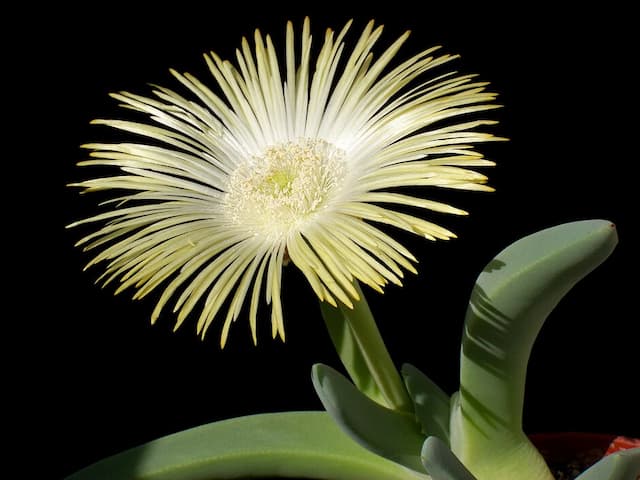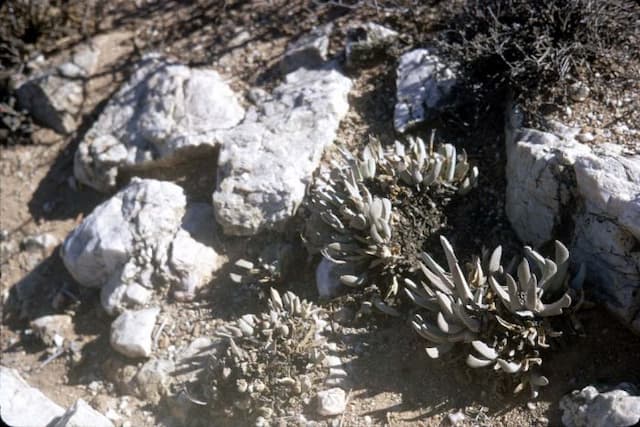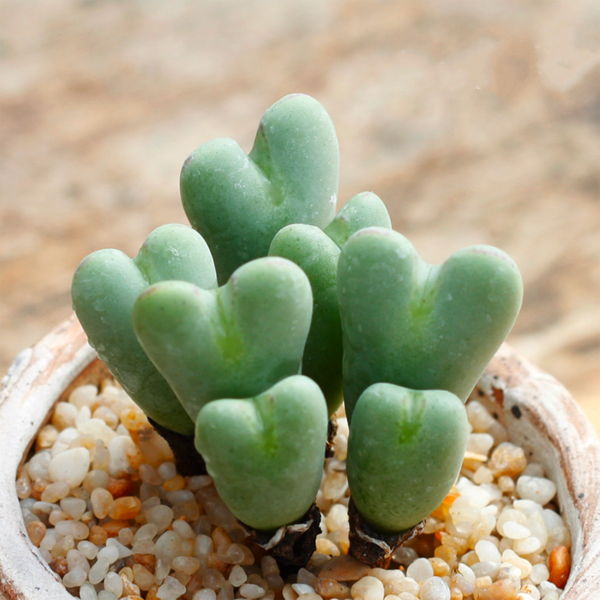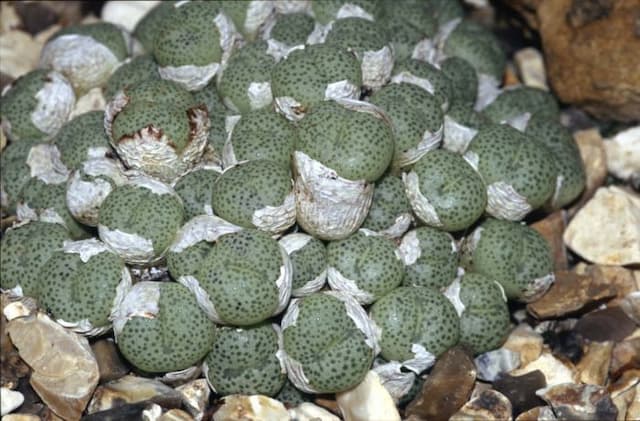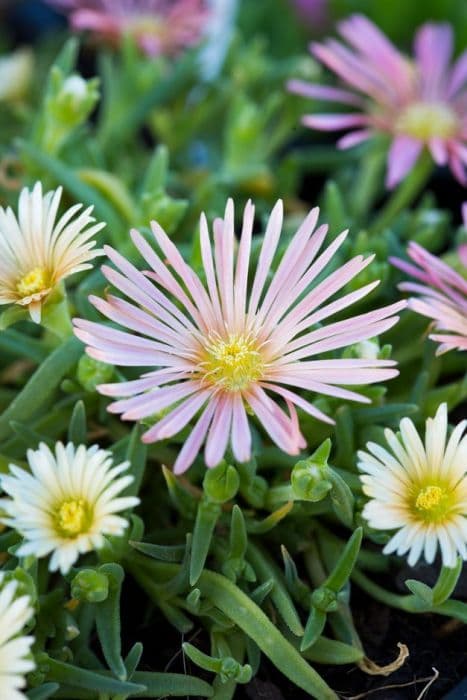Living stones Lithops lesliei

ABOUT
Lithops lesliei, also known as Living Stones, are succulent plants that closely resemble pebbles or small stones. This peculiar mimicry is a natural adaptation to evade predation. They typically have two thick, fleshy leaves that are fused together at the soil level, with a fissure between them. The leaves are mostly grayish to brownish-green, often with patterns or markings that can be dotted, marbled, or webbed in a variety of shades such as red, brown, cream, or green tones, further contributing to their stone-like appearance. During the flowering period, Living Stones can produce daisy-like flowers that emerge from the cleft between the leaves. These flowers are usually yellow or white, adding a touch of vibrant color to the otherwise muted tones of the leaves. After flowering, new leaf pairs emerge, often consuming the old leaves as they grow. The overall impression is one of a small, discreet plant that can easily blend in with its rocky surroundings.
About this plant
 Names
NamesFamily
Aizoaceae
Synonyms
Lesliei Living Stone, Leslie's Living Stone, Living Stones
Common names
Lithops lesliei var. lesliei, Lithops lesliei var. gautengensis, Lithops lesliei var. hornii, Lithops lesliei var. mariae, Lithops lesliei var. venteri.
 Toxicity
ToxicityTo humans
Lithops lesliei, commonly known as Living Stones, is generally considered non-toxic to humans. Ingesting any part of the plant is unlikely to cause poisoning or adverse health effects. However, it's still not advisable to consume ornamental plants as they're not intended for human consumption, and individual sensitivities or allergic reactions could occur.
To pets
Living Stones are also generally considered non-toxic to pets. There's no well-documented evidence that Lithops lesliei causes poisoning in pets. If a pet were to ingest this plant, it's unlikely to suffer from any serious poisoning symptoms. However, ingestion of non-food items can sometimes lead to gastrointestinal upset or blockage, so it's best to prevent pets from chewing on these plants.
 Characteristics
CharacteristicsLife cycle
Perennials
Foliage type
Evergreen
Color of leaves
Grey-green
Flower color
Yellow
Height
1 inch (2.5 cm)
Spread
1 inch (2.5 cm)
Plant type
Succulent
Hardiness zones
10
Native area
South Africa
Benefits
 General Benefits
General Benefits- Easy Maintenance: Lithops lesliei, also known as Living Stones, requires minimal watering and care, making it an ideal plant for busy individuals or those new to gardening.
- Drought Tolerant: As a succulent, Living Stones have adapted to survive in arid conditions, making them perfect for water-wise gardens.
- Unique Aesthetic: With their stone-like appearance, these plants add an unusual and intriguing visual element to any collection or garden.
- Space Saving: Lithops lesliei has a compact size that is suitable for small spaces such as apartments and offices.
- Edutainment: Living Stones offer educational value as they can be used to teach about plant adaptation and mimicry in nature.
- Long Life Span: With proper care, these plants can live for several years, offering long-term enjoyment for gardeners and plant enthusiasts.
- Year-Round Interest: Lithops lesliei goes through fascinating life cycles with periods of flowering and dormancy, providing year-round interest in a collection.
 Medical Properties
Medical PropertiesThis plant is not used for medical purposes.
 Air-purifying Qualities
Air-purifying QualitiesThis plant is not specifically known for air purifying qualities.
 Other Uses
Other Uses- Education: Lithops lesliei, commonly known as Living Stones, are often used in educational settings to teach about succulent adaptations and mimicry, illustrating how plants can evolve to closely resemble their environment.
- Photography: The unique appearance of Living Stones makes them a favorite subject for macro and botanical photographers, offering a chance to capture their intricate details and patterns.
- Art Inspiration: Artists may use Living Stones as a source of inspiration for various forms of art, from painting and sculpture to digital art, due to their distinct and often colorful appearance.
- Feng Shui: In Feng Shui, Living Stones are believed to carry grounding energy due to their rock-like appearance, potentially harmonizing the energy of a space.
- Themed Decor: Living Stones can be integrated into specialized decor themes, such as desert landscapes or minimalist designs, complementing the aesthetic with their unique form.
- Experiential Gardening: Gardeners may use Living Stones to create a hands-on learning experience about water conservation and drought-resistant plants.
- Stress Relief: The care routine for Living Stones, which includes minimal watering and observing slow growth, can offer a form of stress relief and mindfulness for enthusiasts.
- Collectible Hobby: Due to the wide variety of patterns and colors, Living Stones can be collected as a hobby, with enthusiasts often trading or seeking rare specimens.
- Conversation Pieces: When placed in a home or office setting, Living Stones can serve as an intriguing conversation piece due to their unusual appearance.
- Children's Projects: Living Stones are sometimes used in children's educational projects or crafts to teach about plant life cycles and adaptation in a fascinating and engaging way.
Interesting Facts
 Feng Shui
Feng ShuiThe living stones is not used in Feng Shui practice.
 Zodiac Sign Compitability
Zodiac Sign CompitabilityThe living stones is not used in astrology practice.
 Plant Symbolism
Plant Symbolism- Resilience: Lithops lesliei, commonly known as the Living Stones or Living Rocks, symbolizes resilience due to its ability to thrive in harsh, drought-prone environments by mimicking the appearance of stones.
- Adaptation: This plant represents the power of adaptation, as it has developed a unique way to survive by blending into its surroundings to avoid being eaten by thirsty animals.
- Patience: Living Stones are slow-growing plants, which makes them a symbol of patience and the rewards that come from waiting for something to flourish.
- Conservation: The Living Stones often symbolize the importance of water conservation; they're able to store water and go for long periods without it, reminding us of the precious nature of this resource.
- Self-sufficiency: These succulents can symbolize self-sufficiency due to their ability to meet their needs with minimal resources, reflecting a lifestyle that many people aspire to.
 Water
WaterFor the Living stones, water sparingly and aim for a deep watering strategy. Generally, water once every two to three weeks during the spring and fall, which are their active growing seasons, with about 1-2 ounces for small pots. Avoid watering in the summer and winter when the plant is dormant, as overwatering during these periods can lead to rot. It's crucial to allow the soil to dry out completely between waterings. During the dormant seasons, you can mist the plant lightly if it appears particularly shriveled, to prevent dehydration.
 Light
LightLiving stones thrive best in bright light, including direct sunlight. Position them in a spot where they can receive at least four to five hours of sunshine daily. An ideal spot would be a south-facing windowsill where they can bask in plenty of natural light. However, in extreme heats, some light shading during the hottest part of the day can help prevent sunburn.
 Temperature
TemperatureThe Living stones prefer temperature conditions that are typical of desert environments. Maintain a temperature range between 65 and 80 degrees Fahrenheit during their active growth period. They can tolerate temperatures as low as 40 degrees Fahrenheit and as high as 100 degrees Fahrenheit, but changes should be gradual to prevent shock. The ideal climate is dry and warm, avoiding frost which can be fatal.
 Pruning
PruningPruning is not typically necessary for Living stones. These plants rarely outgrow their space or become leggy like other houseplants. However, if there are dead or dying leaves, they can be gently removed to encourage new growth. The best time to do this is at the end of the plant's dormant season, right before new growth begins in the spring.
 Cleaning
CleaningAs needed
 Soil
SoilLiving stones thrive in a well-draining, gritty mix with low organic content, suited for succulents. You can use a combination of coarse sand, perlite, pumice, and a small amount of peat or potting soil. An optimal pH level for Lithops lesliei is between 5.5 and 6.5.
 Repotting
RepottingLiving stones should be repotted sparingly, as they prefer to be slightly root-bound; every 2-3 years is sufficient. It's best to repot during their growing season in the late summer or early fall.
 Humidity & Misting
Humidity & MistingLiving stones require low humidity, being native to arid environments. They thrive in dry air and may suffer in high humidity conditions.
 Suitable locations
Suitable locationsIndoor
Place living stones in bright light, away from high humidity.
Outdoor
In full sun to partial shade; protect from heavy rain.
Hardiness zone
10-11 USDA
 Life cycle
Life cycleLithops lesliei, commonly known as Living Stones, begins its life cycle with seed germination, which generally occurs after rain in its natural habitat, with seeds preferring warm temperatures to sprout. The seedlings develop two succulent leaves that in subsequent years will be absorbed and replaced by a new pair in a process known as renewal. Each year, the Living Stones undergo a dormancy period, where water intake is reduced, and old leaves are reabsorbed as new leaves develop inside the split of the existing leaf pair. Following the dormancy period, around late summer to autumn, Lithops lesliei blooms, producing daisy-like flowers that emerge from the cleft between the leaves. After pollination, which is often done by insects, the plant produces a fruiting capsule containing tiny seeds, which are released when the capsule is wetted by rain. The plant can continue this life cycle for many years, growing slowly and adding more leaf pairs, while older leaves at the base gradually die off.
 Propogation
PropogationPropogation time
Late summer to early fall
The most popular method of propagating Lithops lesliei, commonly known as Living Stones, is by seeds. The best time to sow seeds is in the autumn or early spring when temperatures are mild. To propagate by seeds, sprinkle them evenly onto a well-draining soil mix and lightly cover with a fine layer of sand or grit. The container should be kept in a warm place, around 65-72°F (18-22°C), and maintained with a light mist of water to keep the medium slightly moist until germination, which usually takes about two to twelve weeks. Care must be taken not to overwater, as Lithops are prone to rotting in moist conditions. Once the seedlings have developed a couple of sets of true leaves, they can be carefully transplanted into their own containers.
